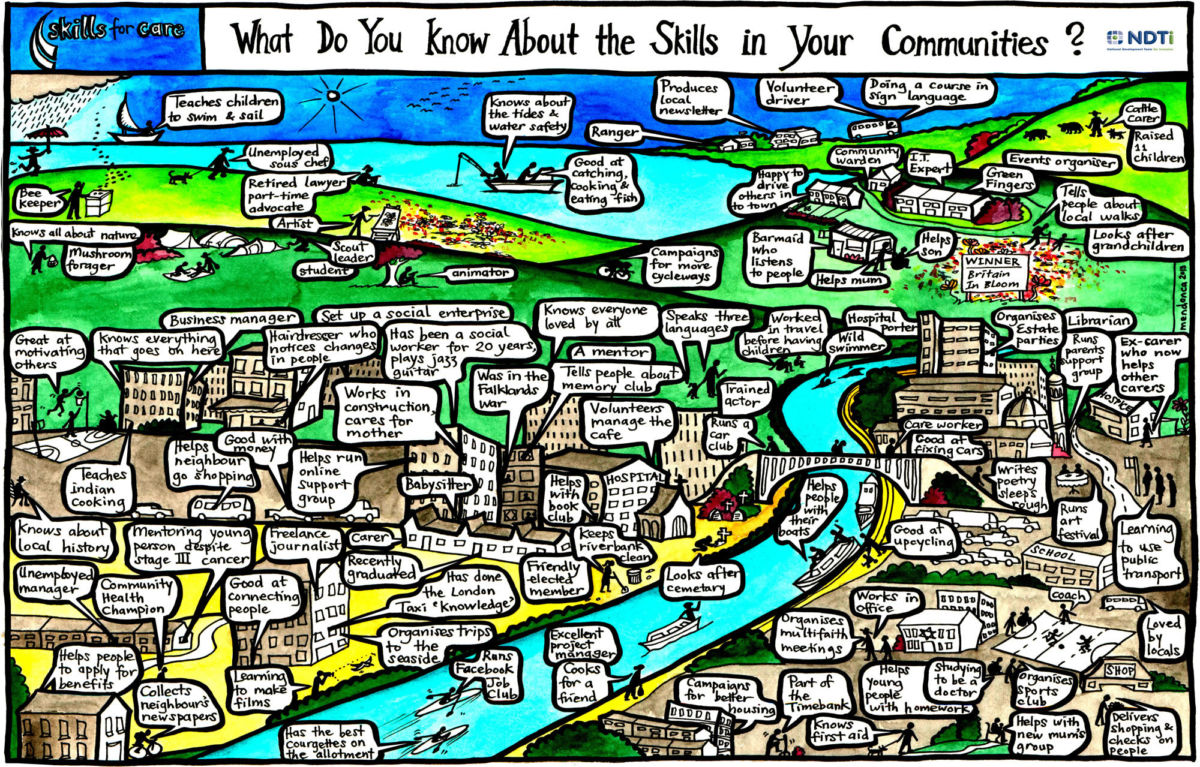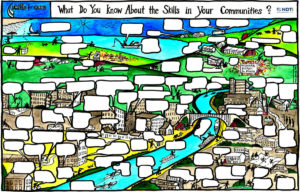
Skills for Care and Nurture Development invitation: Making the invisible visible where you live
Have you seen the above image?
Here is the story behind this image as told by, Jim Thomas from Skills for Care who like us are committed to a capacity oriented approach. I’ve asked Jim to share this for two reasons: 1) it’s a cracker of a story about how art and clever community building can combine to make invisible gifts visible 2) Nurture Development and Skills for Care want to invite interested communities to create their own gifts & skills portrait of their own communities.
Here’s Jim to tell his story about how this wonderful graphic was created:
2013 – sitting in a cafe at the University of the Arts London, Kings Cross, England waiting for my friend and colleague Pen Mendonça to arrive with a rolled-up copy of the map she’d done for another friend and colleague, Melanie Henwood, and I about a programme of work on mapping community skills. Now that the work was completed, I’d asked Pen for a copy of the map. I wanted to frame it and put it on the wall in my study. Little did we know that eight years on the map would still resonate with so many people.
At the time, Pen’s brief was simple: ‘Can you create a map that tells people about the projects and explains what we think the programme was all about?’ This Skills for Care funded programme ran for a number of years, involved over thirty projects, each given a small amount of funding and asked the same question – ‘What skills exist in your local community and how can you share them with others?’ Pen was involved from the start – we wanted to find creative, values-based ways of capturing, analysing and disseminating the research in the hope it would make sense to everyone.
Our focus on skills was not about qualifications. It was based on an understanding that we all have valuable knowledge and experience that we could share if we knew how to and had the confidence that others would be interested in learning from us. We wanted to uncover and celebrate people’s knowledge and skills, to show how much it improves self-esteem and how much it inspires others to make use of the new-found skills and knowledge they have acquired. We wanted to explore an alternative narrative that celebrated every aspect of our rich and diverse communities.
Many of the projects we supported have become a natural part of their local communities and have evolved into something different. The map continues to inspire and resonate, partly because visually it is compelling, and the detail always reveals more on close exploration. When I talk to others about the map its value makes more sense. The map doesn’t differentiate between people on the basis of status, hierarchy or professional standing. It values equally what each and every one of us brings to our community. From the homeless guy who writes poetry, to the person who knows everyone, or the person who delivers shopping and checks on neighbours. They all bring something to the community that enhances and enriches it; they just need to be enabled and empowered to see how each and every one of them is of value. This for me is what the map demonstrates – that a community is not only more than the sum of its parts, but it is also how those parts often unknowingly connect and work together.
The stories from the original projects that always come back to me were from the food bank that taught people how to cook, which inspired those people to develop those skills and get jobs as cooks. Or the story about the person who, coming to the end of their life, was stressed about how messy their prized garden was, and was able to spend the last few weeks of their life teaching volunteers how to garden. Everyone, at all stages of life, has knowledge and skills to share that can improve our lives and the lives of others, and the process of sharing is enriching for both sides.
On the Skills of Care website, you can find out all about the projects that inspired the map. You can also download a copy of the original graphic and a version with blank speech bubbles to adapt and update for local use.
Our Invitation
As we begin to emerge from the Covid pandemic it is especially timely to reflect on the community skills and resources that we need and rely on, including those that have emerged during the crisis. It would be great to collect and share these with each other, to see how much we have in common, how much variety of knowledge and skill there is in our communities, and how we can learn about each other’s communities from each other’s maps. Fill one in for your community or work together with a local artist to develop your own (please pay your artist). Share your community map with the hashtag #shareyourcommunity and we will pull together either an e-book or an online exhibition. Together, let’s create a world map of community skills to support and nurture our collective wellbeing.
Once you’ve created you’re portrait if you’d like to share a copy to encourage other communities and to show how our movement is growing you can send it to: Jim.Thomas@skillsforcare.org.uk
In solidarity with you and your neighbour,
Jim Thomas (Skills for Care) & Cormac Russell (Nurture Development)

